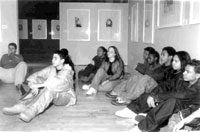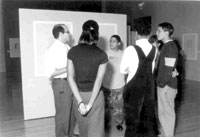|


Young
Artists View Picasso’s Work
By
Marie Holmes
Ninth
graders from the Art & Design High School recently visited
the CUNY Graduate Center to view the exhibit Picasso from Malaga:
Graphic works from the Fundacion Picasso, Ayuntamiento de Malaga,
cosponsored by Instituto Cervantes. On display were a number of
etchings, drypoints, and linoleum cuts dating from 1906 through
1960.
The students were encouraged to carefully examine the panels Sueno
y mentira de Franco (Dream and Lie of Franco), which feature
many of the images made famous in Picasso’s Guernica. This
masterpiece, now housed in Madrid, depicts the horrific 1937 bombing
of Guernica during the Spanish Civil War and is arguably the most
important painting of the 20th century on the themes
of war and violence.
Before viewing the exhibition, the students discussed Picasso’s
artistic techniques and the political situation of his time with
Instituto Cervantes staff and their teacher, Alexis Delbridge.
Harvey Stark, of Instituto Cervantes, explained to the students
that Picasso, in Guernica and related pieces, “is not trying
to represent the event,” but rather, “evoking his feelings about
the event.” Delbridge related Picasso’s politically-inspired art
to students’ work in response to the events of September 11th
and the bombing of Afghanistan.
The students then set off, with copies of Guernica in hand,
to view the works on display and to compare the images and themes
of
Sueno y mentira de Franco to Guernica. They demonstrated
an impressive ability to relate
to the art. Moving from one work to the next in small groups,
the students talked excitedly about the pieces, pointing out images
and techniques that they recognized and often calling their teacher
aside to share their observations.
“The
students were excited to come,” said Delbridge, whose 9th grade
class is currently studying color theory. Delbridge explained
that since they were working with more sophisticated concepts
of color, she thought that the exhibit would provide the students
with a good introduction to Picasso’s pieces for their future
study of the monochromatic work of his Blue Period, as well as
exposing them to one artist’s response to violence and terror.
“I
usually give them an artist’s work to replicate–it gives them
a connection to a piece when they go to a museum and see it,”
added Delbridge while being pulled toward a Picasso etching by
one of her students. Given their response to the exhibition, it’s
difficult to imagine that the students might not immediately connect
with artwork. These young artists proved that they are not only
able but also truly eager to relate to art, on technical as well
as emotional levels.#
For
information about future exhibits or to plan a class trip to the
Instituto Cervantes call 212-689-4232.
Education Update, Inc., P.O. Box 20005, New York, NY 10001. Tel:
(212) 481-5519. Fax: (212) 481-3919. Email: ednews1@aol.com.
All material is copyrighted and may not be printed without express consent of
the publisher. © 2001.
|

